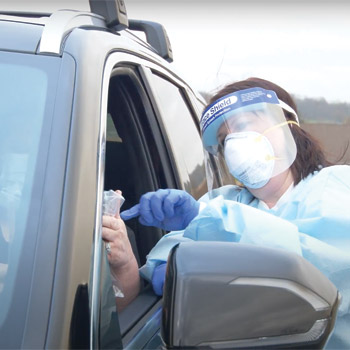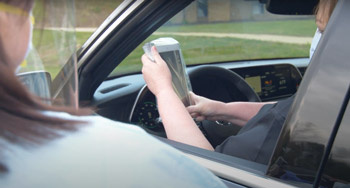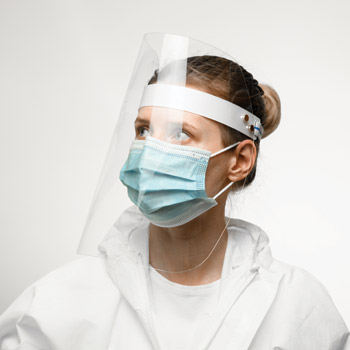Drive-in visits can fill the cracks of telemedicine's reach
Practices in rural areas are tackling the logistics of providing telemedicine to patients who are unable to access it on their own.
With the uptake in telemedicine as a response to the COVID-19 pandemic, it's important to remember that not every patient has access to the necessary technology, especially in rural areas, and not every patient is savvy enough to use what might be available. For Patrick Goggin, MD, FACP, of Medical Associates of Cambridge in rural Ohio, the solution was conducting drive-in visits in the office's parking lot.
Dr. Goggin's grandparents started the practice in the 1930s, complete with house calls, a progression that the COVID-19 pandemic has seemingly forced into reverse. Dr. Goggin's father led the practice from the 1960s into the 2000s. Now Dr. Goggin—along with his brother, ACP Member Mark Goggin, MD; ACP Member Doug Rush, MD, a friend from medical school; Kayode Ojedele, MBBS, FACP; Sandra Schubert, MD; and Rebecca Brauch, MD—operates the practice of seven physicians, six physician assistants and nurse practitioners, and associated staff in a town of about 10,000 people in southeastern Ohio. Dr. Goggin, who is also vice president of Physicians Group of Southeastern Ohio, spoke with ACP Internist about the logistics of providing telemedicine to patients who are unable to access it on their own.
Q: What is it that you're doing in terms of “parking lot” visits?
A: As with many practices, we on-boarded virtual visits via a telehealth platform at the beginning of the pandemic. But being in rural Ohio, with a large census of senior patients, we're finding there's a significant technology gap. Many of our patients, especially older people in more rural settings with a higher burden of chronic disease, had a technology gap, either where they didn't have smartphones or didn't have internet access, and were unable to do virtual visits. Colleagues from Pittsburgh, who are among the 12 practices we collaborate with through a partnership with agilon health, let us know that they were doing some parking lot virtual visits. We adapted their plan and designated an office iPad with cellular access so the patients could come to our parking lot.

We created a dedicated front desk phone line so the patients can let us know when they arrive. A receptionist wearing personal protective equipment [PPE] would take the fully cleansed iPad out and initiate the visit. We hand the iPad to the patients in their car. Meanwhile, a doctor or advanced practitioner would then joins the visit via the portal, and conducts the virtual visit while the patient is just a few yards away out in their car, without the potential risk of exposure by coming into our office or being in our waiting room.
Q: Do you have any patients in your offices at any point now, or is it all telehealth?
A: We are still doing face-to-face encounters every day. We have essentially eliminated patients from our waiting room or congregating in any sort of public areas of the office. So in addition to doing the parking lot virtual visits, we've also created a virtual waiting room in which we ask people to come for their face-to-face encounter, remain in their car, call the dedicated front office line, and our receptionist completes intake tasks over the phone, has them wait in the car until we have an exam room ready, and then we call them in when we can take them directly to an exam room, bypassing the waiting room.
Q: How do you determine who gets a face-to-face visit versus who gets a parking lot visit?
A: The doctors have been looking at their schedules and identify the highest-risk patients based on age, chronic conditions like COPD, heart failure, diabetes, or chronic kidney disease, or immunocompromised state and advising them to not come into the office. We strongly encourage those people either to have a telehealth visit or a drive-in virtual visit, or to simply defer their care for another month or two.
Q: How do you manage the staffing of a parking lot visit?
A: Our staff presence in the parking lot is limited to a receptionist who takes the iPad out and retrieves it at the end of the encounter, and we're also doing parking lot blood draws. We have a phlebotomist going out to the parking lot in full personal protective equipment and drawing blood in the parking lot. Occasionally a medical assistant might help with checking a blood pressure or checking an oxygen level. But really, it's just a handful of designated people. We're trying to keep traffic in and out of the building fairly low.

We just ask that when staff come back in, they take off any PPE that they have, and cleanse their hands and cleanse the iPad. Inside our office, we're taking precautions like most workplaces are, where everyone is at least six feet apart from each other and wearing masks all the time.
Q: How many of these parking lot visits might you do on a typical day? What's a broad rough average?
A: Our total virtual visits probably peak at around 35 per day. The virtual drive-in visits might be about five a day. So it's really not a large volume. But we know it helped fill in the cracks with some of our most vulnerable patients.
Q: What have the patient uptake and acceptance been like?
A: It's been well received by both the patients who are doing virtual visits at home, and the patients doing the drive-in virtual visits. There still can be some technology issues, especially when people are at home, depending on their internet service or devices. But this process has certainly helped allow us to provide care to our patients, many of whom are in the highest-risk categories and who need the care most and for whom it would not be safe for them to come into the office.
Q: What's the reimbursement for a parking lot visit?
A: It's the same as if as if it's a telehealth visit. CMS has stated that virtual visits will be reimbursed at the same rate as face-to-face encounters. And for the most part, we are getting reimbursed. Some have been denied and we're working those denials just like we would any others. I think it came on so quickly that the payers weren't ready.
It's not like we've got a line of cars down the street; we're not doing a high volume of these virtual drive-in visits. But we do feel like it's helped. There's not one answer to caring for patients in this pandemic. There's a lot of different answers, and you have weave them together, to try to reach as many of your patients as possible. This has been one of the tools we're using which is helping connect us to some of our most vulnerable patients.





